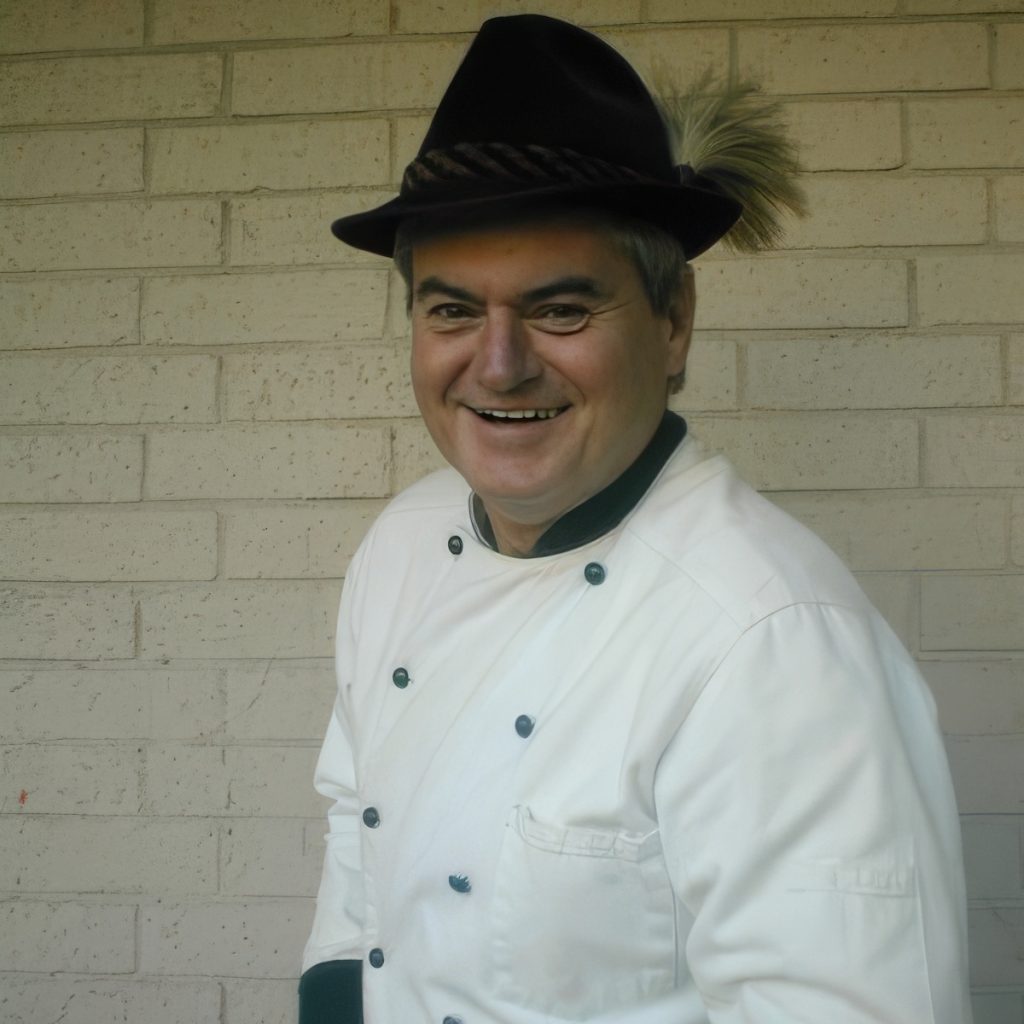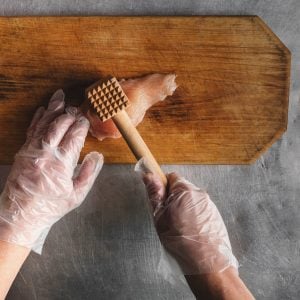I met Chef Achim (Keem) Thiemermann years ago on the Internet. Chef Keem is from Germany and came to this country after a career as a pop music composer/arranger and record producer during the 70’s. He came to the United States in 1981 with two suitcases and $500 in his pocket and started from scratch.
He attended the Le Chef culinary school, now called the Texas Culinary Academy, and worked in many restaurants before starting his own business in 2001, manufacturing a product called Agasweet and spending two months a year in Alaska working as Executive Chef for the Driftwood Lodge.
Chef Keem has done and seen a lot in the food industry, and I think you will enjoy this interview. His contact information is at the end of the page.
Chef Keem, you started in the German pop music business in 1970, came to the United States in 1981, and went to culinary school in 1991/1992. What got you interested in a career in the restaurant industry?
Well, I was always interested in cooking – for myself and for my friends. Usually, it was a “hit or miss” affair, though. Once, I dumped a can of expensive wild mushrooms into some cooked rice for a special treat for my 2 Texan buddies visiting me in Munich. I had no idea one should exercise caution with canned liquid that foams lively after removing the lid.
My sturdy friends from Texas slept peacefully after our dinner. But I was up all night, running back and forth between my upstairs bedroom and the downstairs bathroom.
I also spent a good chunk of time with a mop bucket the next morning…but I digress somewhat. (Note: A dented can with foaming liquid spells “botulism,” my friends! Discard quickly.)
In Germany, most people start a career after extensive schooling, or with an apprenticeship. I came to America and noticed quickly that in this land of unlimited opportunities (and dentist bills), you can simply go ahead and do what you like to do – while training on the job.
So, I decided to indulge my life-long interest in cooking and applied for a kitchen position at a new Austin, TX restaurant. The owner took a liking to me and promised to train me to become a line cook in his place.
I enjoyed learning all their recipes and discovered my passion for the dynamics of a busy restaurant kitchen line. (Don’t even consider becoming a chef unless you are sure you have this passion!)
Did you do much cooking before you went to cooking school?
After two years on my first kitchen job, I worked for several more places, including one hotel, a cafe, a Cajun restaurant, a BBQ joint, and a couple of All-American diners.
How did you pick Le Chef, now called the Texas Culinary Academy, part of the Le Cordon Bleu schools?
It’s a “story”, you know. I didn’t have much money, and paying for chef school seemed out of the question. And, to be honest, I thought I was too old to go back to school at 42 years of age. In 1990, I spent a year volunteering once a week at an AIDS Hospice.
One day, a man brought in his partner, who was in the last stages of his life. I had noticed the bumper sticker on that man’s van; it said “Le Chef.” So I asked him about this chef school, and I shared my passion for cooking.
As it turned out, this guy was the chef/ owner of “Le Chef.” He invited me to visit the school and interview with his enrollment person.
He also waved off my concerns about age and finances (or the lack thereof), telling me that they have a lot of late-starters at their school and that they can take care of a student loan for me. Wow! The rest is (my) history!
At that time, “Le Chef” was the only gig in town, so I didn’t get involved in any comparison business regarding cost, reputation, etc. Today, with hundreds of new culinary schools opening every year, it is advisable to shop around.
Your decision can be made more accessible if you’ve worked in professional kitchens before considering going to school. A CIA graduate will find many open doors but might start with an empty pocketbook. A smaller, less expensive school or even a Community College Culinary Program can teach the basic classic cooking techniques just as well.
What was your experience at Le Chef like?
Oh, I loved every minute of it! School hours were from 7 – 11 a.m., and I worked at a restaurant in the p.m. Looking back today, we could take our time to learn everything right. Of course, there were days when we had to practice timing and speed.
If a dish had to be presented at 10:45, the chance for a good grade disappeared at 10:46. (We still got graded, but no cigar!) There’s pressure, yes, just like in real life – but nothing to be afraid of. We all made it through in the end. (I finished at the top of my class. There. LOL)
I truly enjoyed the lectures, learning about the chemical laws behind cooking and baking and the history of our profession. I re-typed my class notes in the afternoon, deepening the retention of our course materials. The school library had books and videos, and we formed study groups among friends. We had a blast!
It helps when you have a certain degree of maturity and know that you want what they can teach you. Commitment is one word. Dedication, focus, and determination are a few other helpful qualities.
Were you trained in classic French cooking, or did they train you in cooking styles from around the globe?
We were taught classic French cooking, but the methods were applied to some international specialty recipes – mainly German, Italian, and American dishes.
What was the most crucial lesson you received from your experience at Le Chef?
The importance of teamwork and interdependence. We all need to work as a team to make it come together in a fabulous dish, cooked right and presented perfectly.
This means we must watch out for and support each other within a kitchen brigade. If I’m done with my part, let’s see if I can help someone else. A spirit of generosity makes everything easier and better for everyone involved.
Can you recall a funny culinary student story and share it with us?
Do you mean the story when we had the ice carving course and my class partner and I decided to do a “dolphin jumping out of the water”? When our chef thought we had created a grossly obese whale rolling through the waves?
No…I’m not going to share this story; it’s too embarrassing!
How would you compare your training back in 1992 with the culinary education taught today?
My knowledge about today’s teaching methods comes mainly from books and TV shows. I’ve gone back to visiting my alma mater a few times, too. My impression is that chef schools have dramatically grown and improved.
The tremendous popularity of our profession through shows like Top Chef and the Food Network has provided much more money for schools. Equipment, resources, knowledgeable teachers – all this has improved since I’ve gone through school.
After graduating, you specialized in “wedding cakes and candy.” What led you to this area of culinary arts?
I love the creative and artistic aspects of working with food. You can shape almost anything with sugar paste (fondant), “paint” with food colors, and even make your molds with food-grade silicon. The artist in me is drawn to this line of culinary work.
And – I love to eat sweets. Just recently, I’ve developed a new candy for my company, Sweet Venus Delights – a scratch-made caramel enrobed in dark chocolate and topped with white chocolate holding a sprinkle of espresso sea salt. Di. Vine!
How is it different from “working the line”?
It’s usually not as hectic as working a busy dinner line. One can plan and finish the project according to a primarily consistent schedule. No unexpected large groups are showing up 15 minutes before closing time, demanding the most elaborate dishes, of course.
I’ve had brides calling me 18 months before their wedding date, wanting to schedule a meeting to discuss their cakes. I said, Honey – relax; who knows if you still want to get married a year from now?
Many young and old people have contacted me and asked about attending culinary school. What advice would you give them to help them decide if this is the best choice for them?
If you want to be a chef in a restaurant or hotel kitchen, you need to be able to stand the heat. Be aware that the hours are long, the temperature in the kitchen might reach triple digits (depending on your air conditioner, or the lack thereof), and the pressure on the line can be nerve-wracking for hours.
If none of this matters to you, try working in a busy kitchen for a while. Some people have asked famous chefs for a job without pay to gain great insights into their potential career choices.
But you can always start as a prep cook in a busy neighborhood joint and then move up to a line cook position. For pay, of course. (Lousy, maybe – but pay.)
But you don’t have to become a restaurant/hotel chef to work in the food industry. Many other career options require a culinary education: catering, test kitchens, personal/private chef, food manufacturer/small biz owner (like myself now), food writer, etc.
It’s up to you to determine what you want to do. People in the industry are usually beneficial with advice and trial opportunities. Find a person doing exactly what you want to do, and talk to them. Ask if you can help them in any way while gathering information for yourself.
Or, if you have so much money that it doesn’t matter if you paid $50k to find out it’s not your cup of tea – give me a call, please.
What personal characteristics are essential to be successful in the food industry?
It would be best if you had a sense of humor, be creative, generous, determined, persistent, and flexible. In that order. Or vice versa. Did I mention flexibility?
You developed a “gourmet sweetener” called Agasweet back in 2004. Can you tell us a little bit about this line of products and how home cooks can use it?
In 2003, I used this reasonably new natural sweetener, agave nectar, in my healthier line of pastries. Agave nectar has a low glycemic index rating, which doesn’t give you a sugar rush.
Even most diabetics can use it for their sweetening needs. Another excellent quality of agave syrup is that it enhances the flavors of whatever you use it with. It never crystallizes as honey does and does not need to be refrigerated. It’s also perfect for cooking and baking.
Around the same time, I was introduced to the power of essential oils. Some of these are approved for consumption, like lemon, tangerine, ginger, cinnamon, peppermint, lavender, and others.
This gave me the idea to combine the goodness of agave nectar with the wonderful flavor and healing properties of essential oils to create the best possible natural sweetener I could think of. Voila – Agasweet!
Although it is a perfect sweetener, there is so much more you can do with Agasweet. Use it as a healthy pancake syrup, drizzle some over fruit or cheese, and squeeze a few lines on your sandwich…you see, to create an authentic flavor explosion in the mouth, we need to address all taste buds simultaneously – salty, sour, bitter, and sweet. It makes culinary sense to add a little sweetness to any savory dish.
And the fabulous flavors enhance our recipes from standard to “gourmet” – Cinnamon Agasweet with Teriyaki Salmon, Lavender Agasweet with Roasted Lamb, Lemon Agasweet with Baked Halibut, Tangerine Ginger Agasweet with Sauteed Shrimp…to name just a few examples.
Agasweet makes a gourmet chef out of you – with a simple squeeze or two! End of commercial.. 🙂
You are also manufacturing your line of candy. Can you tell us how you got into the candy business a little bit about your line of products, and where we can find it?
Along with my studies on wedding cake design, I learned a lot about tools and materials for candy production. I started with molded chocolates in many shapes, primarily for holidays or personal celebrations.
The variety of candy and chocolate molds available is amazing! After a while, I had the idea of creating a line of flavored chocolate bars and offering custom-designed sleeves.
A number of businesses – neighborhood markets, book stores, advertisement companies – order my chocolates with their logos on the wrapper. I use a dark molding chocolate by Guittard, melt it and add my unique flavoring components: crushed espresso beans, crumbled coconut macaroons, a peanut butter praline, etc.
I pour this mixture into bar molds, let them set in the freezer for about 10 minutes, turn them out and wrap them in silver foil. Then I wrap these in my custom sleeves.
I sell these custom bars online and I’ll provide a link at the end of this interview. Still in preparation for online sales are my Tres Leches Coconut Macaroons and my new Espresso Sea Salt Caramel Truffles.
I any case, if you like to order any of the things discussed here, you may email me anytime and I will try to accommodate your wishes.
Many home cooks tell me they have a fear of trying something new in the kitchen. They tend to prepare the same 6 or 7 meals week after week, month after month, year after year. What advice would you give these home cooks to get over their fear and start trying some new recipes?
Make small changes. Of course, I recommend experimenting with all the different flavors of Agasweet. This will open your palate to new flavor combinations and provide new excitement to your regular dishes. And it’s easy to use. Increase your seasoning by 25-50 percent—not the salt, but the herbs and spices.
Get bolder! Learn how to sear properly. A piece of chicken, meat, or fish tastes so much better with a caramelized crust on the outside and a tender, moist interior.
Having mastered this technique, you might like to get more adventurous and try your hand at things other than your regular fare: fresh tuna steaks, pork tenderloin medallions, lamb chops, blow fish…um…scratch the blow fish, please!
Here’s another important point: After a proper searing you’re left with a wonderful fond in your pan. This can be deglazed with brandy or bourbon, red or white wine, and finished with cream. That’s where the eating fun begins – the sauce!
What top 5 cooking mistakes do find most home cooks?
Overcooking fish, overcooking pork, overcooking roasts, not taking enough time for cooking, not making enough time for learning how to cook right
What are Chef Keem’s top 5 cooking tips or suggestions for a novice cook?
Read cook books, watch cooking shows and take notes, apply what you’ve learned. Really. Do it. Learn and practice one classic technique each month (or week). Research “searing”, “braising”, “roasting”, “sauteing”, etc. on the internet and in your books.
Practice. Sear on high heat, get your kitchen hot! Make noise. Bang pans. Have fun. Play some music.
What 5 cookbooks would you recommend every home cook own?
- “The Way To Cook” – Julia Child
- “Joy Of Cooking” – Irma S. Rombauer
- “Jaques Pepin’s Complete Techniques” – Jaques Pepin
- “The Pie And Pastry Bible” – Rose Levy Beranbaum
- “The Cake Bible” – Rose Levy Beranbaum
What is the most underrated ingredient in your opinion and how would you prepare it?
Essential oils. Added after the cooking is completed. Look on the web for the so called FDA GRAS list (Generally Recognized As Safe). Under ‘essential oils’, find the flavors you like. Or better, visit your local health store and consult with them on the subject matter.
You need to get food-grade essential oils! Be careful with your application – essential oils are powerful. One drop or two go a long way in flavoring your foods and providing substantial health benefits over a period of regular usage. Educate yourself first, then enjoy.
What is your favorite cooking gadget?
My digital thermometer.
I also know that you spend part of the year in South East Alaska at the Driftwood Lodge for the Alaska Expedition Company as the executive chef. Can you tell us how you landed that gig, what it is like and what are you cooking?
In 1998, I was looking for a different job. There was an ad on the job board of my alma mater, “Le Chef”, and I responded to it. This year, I’ll be going for the 12th straight season to my gig in SE Alaska: Executive Chef for the Driftwood Lodge.
Fly fishermen from across the country come to the lodge during the silver salmon season between August and October. Some of them even go bear hunting. Or moose.
The season lasts about 2 months, and our guest groups change every week. Although the lodge is in a remote area, I’ve set myself up with quite a professional kitchen with walk-in cooler and freezer, and all the tools I need for a gourmet menu. All my supplies are flown in from Anchorage, on a DC-3 that lands on the sand by the river.
My dishes include salmon, of course – blackened or roasted. I make a hot and crunchy halibut, roasted pork loin, Black Angus beef tenderloin steaks, New Zealand baby lamb chops, sauteed chicken breast, and many other recipes as they pop into my head while I’m there.
The beauty of the job is that I have no budget restrictions and I can play all day long. With food. My favorite game.
When cooking at home, what do you like to prepare for yourself?
Sandwiches. No, really! I love sammies. And chopped steak. Meat loaf. Chicken breast. Fried potatoes with onions. I enjoy basic stuff, simple dishes created from what I find in the fridge.
I get good-quality ingredients at the farmers market every Saturday. The best cheeses from Mennonites outside of Dallas. Fresh Texas ground lamb, grass-fed beef, artisan breads. And great seasonal veggies. My trick is to upgrade all my dishes with – you guessed it! – a squeeze of Agasweet.
What is your signature dish or your favorite recipe?
I don’t have a single signature dish. However, I have a few specialty preparations and I am more than glad to share my recipes with you. And with pictures. On my Squidoo lenses. Come visit!
Thank you and I hope you enjoyed the interview.
Thank you for inviting me. I love to share myself in everything I know – it’s not that much to begin with. Feel free to contact me with any questions you may have.
Warmest regards, Your Chef Keem




